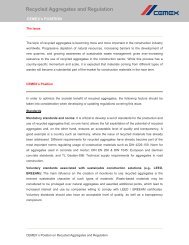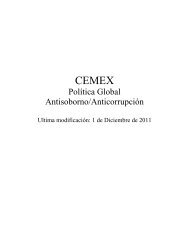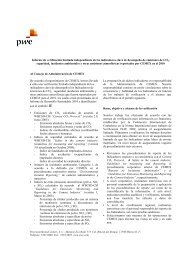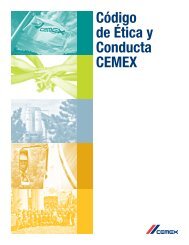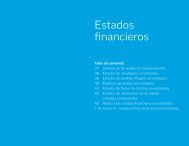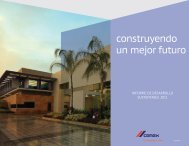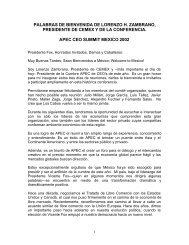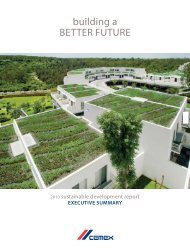building a STRONGER foundation - Cemex
building a STRONGER foundation - Cemex
building a STRONGER foundation - Cemex
You also want an ePaper? Increase the reach of your titles
YUMPU automatically turns print PDFs into web optimized ePapers that Google loves.
MFRS C-18, “Asset Retirement Obligations” (“MFRS C-18”)<br />
CEMEX, S.A.B. DE C.V. AND SUBSIDIARIES<br />
Notes to the Consolidated Financial Statements – (Continued)<br />
As of December 31, 2010, 2009 and 2008<br />
(Millions of Mexican pesos)<br />
In December 2010, CINIF issued MFRS C-18, which beginning on January 1, 2011, establishes guidelines for measurement and recognition<br />
of obligations associated with the retirement of property, plant and equipment, as well as obligations in connection with environmental<br />
remediation upon retirement of a component of fixed assets. Retirement activities comprise permanent elimination, dismantling, demolition,<br />
sale, abandonment and recycling, among others. Under MFRS C-18, such obligations should be measured by the net present value of<br />
expected cash flows required to meet the obligations and should be initially recognized against the acquisition cost of the related asset.<br />
Changes in the estimation as a result to modifications in discount rates are recognized through the financing cost, while changes in cash flow<br />
estimations are recognized against the corresponding asset. Before MFRS C-18, as a general matter, other MFRS provided for the same<br />
recognition of the obligation against the related asset, and measurement techniques were obtained from international financial reporting<br />
standards, very similar to the actual guidelines of MFRS C-18. Consequently, CEMEX does not anticipate any material impact to its financial<br />
statements as a result of the adoption of MFRS C-18 in 2011.<br />
Improvements to MFRS 2011<br />
In December 2010, CINIF also issued several improvements to certain existing MFRS. The most significant changes in respect to existing<br />
guidelines, beginning on January 1, 2011, are as follows:<br />
Bulletin C-3, “Accounts receivable.” Changes require that interest income should be accrued to the extent the amount could be<br />
reasonably quantified and the recoverability is probable. In addition, doubtful accounts should not generate interest income.<br />
MFRS C-10, “Derivative financial instruments and hedging activities.” Changes clarify that: (i) certain effects can be excluded from<br />
effectiveness tests; (ii) the designation as a hedge of an intercompany forecasted transaction when functional currencies are different is<br />
allowed; and (iii) the gross presentation of margin accounts is required.<br />
Bulletin D-5, “Leases.” Changes incorporate guidance to: (i) determine the discount rate to measure a capital lease; (ii) require additional<br />
disclosures for such capital leases; and (iii) modify the moment when a gain or loss for a sale and lease back transaction should be<br />
recognized.<br />
Except for the reclassification of margin accounts associated with derivative instruments (note 2E), which are currently offset against the<br />
liabilities that CEMEX has with its counterparties, CEMEX does not anticipate any material impact to its financial statements as a result of<br />
the adoption of these MFRS improvements in 2011.<br />
F-19



